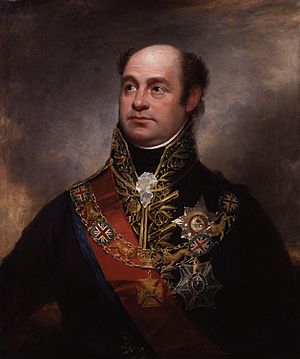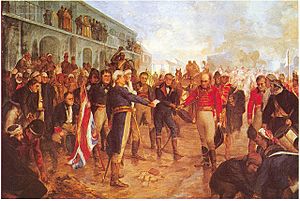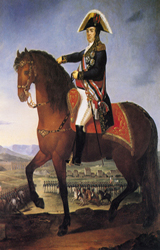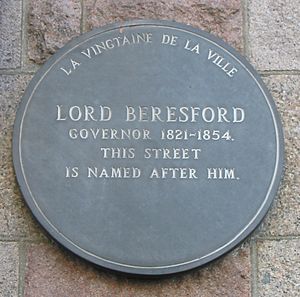William Beresford, 1st Viscount Beresford facts for kids
Quick facts for kids
The Viscount Beresford
|
|
|---|---|

Lord Beresford by Sir William Beechey
|
|
| Born | 2 October 1768 Bedgebury Cross, Kent, England |
| Died | 8 January 1854 (aged 85) Kilndown, Kent, England |
| Buried |
Christ Church, Kilndown
(51°05′27″N 0°25′37″E / 51.090735°N 0.426909°E) |
| Allegiance | |
| Service/ |
Army |
| Years of service | 1785–1830 |
| Rank | General (UK) Field marshal (Portugal) |
| Commands held | Master-General of the Ordnance |
| Battles/wars | War of the First Coalition The Egyptian Campaign British invasions of the River Plate Peninsular War |
| Other work | Governor of Jersey Governor of Royal Military Academy |
General William Carr Beresford, 1st Viscount Beresford (2 October 1768 – 8 January 1854) was an Anglo-Irish soldier and politician. He was a high-ranking officer in both the British Army and the Portuguese Army. He fought alongside The Duke of Wellington during the important Peninsular War. He also served as the Master-General of the Ordnance in 1828, a top military role in the British government.
Contents
Early Life and Military Start
William Carr Beresford was born in 1768 in Kent, England. He was the son of the 1st Marquess of Waterford. He had several brothers who also became important military figures.
Beresford joined the British Army in 1785. Early in his career, he had an accident with a musket that caused him to lose sight in one eye. Despite this, he continued his military service. He was promoted to captain by 1791.
Early Battles and Campaigns
Beresford showed bravery in several early campaigns. He fought at Toulon in 1793. He also served in Egypt from 1799 to 1803. Later, he fought in South Africa in 1805.
In 1806, Beresford led a small British force to invade the River Plate region in South America. This area is now Argentina. He attacked Buenos Aires without official permission from the British Crown. The British troops occupied Buenos Aires for 46 days. However, local forces led by Santiago de Liniers fought back. After two days of intense fighting, the British were defeated. Beresford had to surrender and was held prisoner for six months. He eventually escaped and returned to England in 1807.

The Peninsular War
The Peninsular War (1807–1814) was a major conflict in Spain and Portugal. It was part of the larger Napoleonic Wars. Britain and Portugal fought against France.
Leading the Portuguese Army
In 1809, Beresford was sent to Madeira, an island belonging to Portugal. He served there as Governor and Commander in Chief for six months. The Portuguese Royal Family had moved to Rio de Janeiro, Brazil, to escape the French invasion. They needed a strong leader to train and organize their army.
The Portuguese government asked Britain for help. They wanted Arthur Wellesley to lead their army. Wellesley, who later became the Duke of Wellington, suggested Beresford instead. Beresford was then made a Marshal and Commander in Chief of the Portuguese Army in March 1809.
Beresford quickly improved the Portuguese forces. He made them more disciplined and organized, similar to the British Army. He changed army rules, created an artillery command, and removed officers who were not doing a good job. He replaced them with better leaders.
Fighting Alongside Wellington
In April 1809, Sir Arthur Wellesley arrived in Lisbon. He took command of all the combined British and Portuguese troops. Beresford was then named Marshal General of the Portuguese Army.
The allied armies marched north. Wellington's troops moved to Porto, while Beresford's forces marched through the Beira Province. Wellington's army crossed the Douro river and defeated the French. This forced the French Marshal Soult to leave Porto. Beresford's positioning helped trap the French. They had to leave Portugal by difficult roads, abandoning their artillery and supplies.
After this victory, the allied armies moved south. Beresford worked hard to reform the Portuguese military. He inspected different army groups and corrected problems. His efforts greatly improved the Portuguese Army. This was very important when Napoleon's forces invaded Portugal for a third time.
The Portuguese troops showed their strength at the Battle of Buçaco in September 1810. They played a key role in this battle. They also helped defend the strong Lines of Torres Vedras, which protected Lisbon.
Battle of Albuera
In 1811, Beresford led a combined army of British, Portuguese, and Spanish soldiers. He intercepted a French army that was trying to protect the Spanish fortress of Badajoz. Beresford had been besieging Badajoz, but he lifted the siege when he heard the French were coming.
He positioned his army at Albuera in a strong defensive spot. On May 16, 1811, he defeated the French forces in the bloody Battle of Albuera. The French were forced to retreat. After this battle, Beresford was given the title of Count of Trancoso in Portugal.
Later Campaigns and Injuries
In July 1811, Beresford suffered from "nervous breakdowns." He recovered by February 1812 and rejoined Wellington. He helped in the capture of Ciudad Rodrigo and the Siege of Badajoz.
After Badajoz was captured, Beresford and Wellington moved to the Águeda River. From there, they launched the Salamanca campaign. On July 22, 1812, the important Battle of Salamanca took place. This was a major victory for the Anglo-Portuguese forces over the French. During the battle, Beresford was badly wounded while leading Portuguese troops.
He returned to Lisbon to recover and was ill for several months. In December 1812, he was given the title Marquis of Campo Maior in Portugal. By March 1813, he was well enough to rejoin the army as second-in-command. He helped Wellington liberate Spain.
Beresford also helped in the invasion of France. He was seen as the liberator of Bordeaux. He fought in the Battle of Toulouse, which was the last major battle of the Peninsular War.
During the Peninsular War, Beresford was present at many key battles. These included A Coruña, Busaco, Albuera, Badajoz, Salamanca, Vittoria, the Pyrenees, Nivelle, Nive, Orthez, and Toulouse. He received a special medal with seven clasps, showing his many achievements. Only the Duke of Wellington had more clasps.
Later Career and Legacy
After the war, Beresford returned to England. He later went back to Lisbon to lead the Portuguese Army again. He tried to get involved in Portuguese politics, which caused some disagreements. He then traveled to Brazil to meet with the Portuguese Royal Family. He returned to Portugal with more power.
However, the Liberal Revolution of 1820 in Portugal changed things. Many British officers were dismissed. The new government would not even let Beresford land in Portugal.
In 1821, he became the Governor of Jersey, an island near France. He held this position until his death in 1854. He was the last person to hold the full title of Governor of Jersey.
Beresford was also the colonel of several British regiments during his career. In the 1840s, he expanded his estate in Kent, England. He also built the village of Kilndown nearby.
His Impact and Recognition
Some historians criticized Beresford's tactics at the Battle of Albuera. However, Wellington respected Beresford's skill as a military organizer. Wellington even said that Beresford should take command if he himself could not.
For his service against the French, Beresford was given the title Baron Beresford in 1814. In 1823, he was further honored as Viscount Beresford. He also received many awards from Portugal, including the Grand Cross of the Order of the Tower and Sword.
Beresford County, in New South Wales, Australia, was named after him. So was Beresford, New Brunswick in Canada.
Family Life
Lord Beresford married his cousin, Louisa, in 1832. She was the widow of Thomas Hope. They did not have any children together. Louisa died in 1851.
Lord Beresford passed away in January 1854 at the age of 85. Since he had no children, his titles of Baron and Viscount ended with his death. His estates were passed to his stepson.
Images for kids
See also
 In Spanish: William Beresford para niños
In Spanish: William Beresford para niños
- List of Marquesses in Portugal
- List of Countships in Portugal
- Beresford Gate
- Beresford Square





